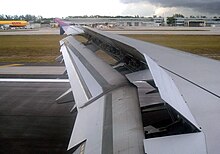



In aeronautics, a spoiler (sometimes called a lift spoiler or lift dumper) is a device which intentionally reduces the lift component of an airfoil in a controlled way. Most often, spoilers are plates on the top surface of a wing that can be extended upward into the airflow to spoil the streamline flow. By so doing, the spoiler creates a controlled stall over the portion of the wing behind it, greatly reducing the lift of that wing section. Spoilers differ from airbrakes in that airbrakes are designed to increase drag without disrupting the lift distribution across the wing span, while spoilers disrupt the lift distribution as well as increasing drag.
Spoilers fall into two categories: those that are deployed at controlled angles during flight to increase descent rate or control roll, and those that are fully deployed immediately on landing to greatly reduce lift ("lift dumpers") and increase drag. In modern fly-by-wire aircraft, the same set of control surfaces serve both functions.
Spoilers were used by most gliders (sailplanes) until the 1960s to control their rate of descent and thus achieve a controlled landing. Since then, spoilers on gliders have almost entirely been replaced by airbrakes, usually of the Schempp-Hirth type. Spoilers and airbrakes enable the glide angle to be altered during the approach while leaving the speed unchanged.
Airliners are almost always fitted with spoilers. Spoilers are used to increase descent rate without increasing speed. Their use is often limited, however, as the turbulent airflow that develops behind them causes noise and vibration, which may cause discomfort to passengers. Spoilers may also be differentially operated for roll control instead of ailerons; Martin Aircraft was the first company to develop such spoilers in 1948.[1] On landing, however, the spoilers are nearly always fully deployed to help slow the aircraft. The increase in form drag created by the spoilers directly assists the braking effect. However, the most gain comes as the spoilers cause a dramatic loss of lift and hence the weight of the aircraft is transferred from the wings to the undercarriage, allowing the wheels to be mechanically braked with less tendency to skid.
In air-cooled piston engine aircraft, spoilers may be needed to avoid shock cooling the engines. In a descent without spoilers, air speed is increased and the engine will be at low power, producing less heat than normal. The engine may cool too rapidly, resulting in stuck valves, cracked cylinders or other problems. Spoilers alleviate the situation by allowing the aircraft to descend at a desired rate while letting the engine run at a power setting that keeps it from cooling too quickly (especially true for turbocharged piston engines, which generate higher temperatures than normally aspirated engines).
- ^ "Spoilers Aid Aileron Control." Popular Science, August 1948, p. 91.